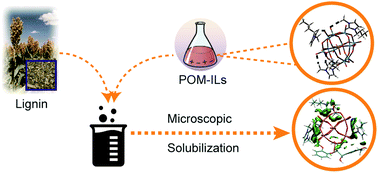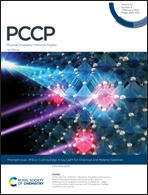Theoretical study on the microscopic mechanism of lignin solubilization in Keggin-type polyoxometalate ionic liquids†
Abstract
Keggin-type polyoxometalate derived ionic liquids (POM-ILs) have recently been presented as effective solvent systems for biomass delignification. To investigate the mechanism of lignin dissolution in POM-ILs, the system involving POM-IL ([C4C1Im]3[PW12O40]) and guaiacyl glycerol-β-guaiacyl ether (GGE), which contains a β-O-4 bond (the most dominant bond moiety in lignin), was studied using quantum mechanical calculations and molecular dynamics simulations. These studies show that more stable POM-IL structures are formed when [C4C1Im]+ is anchored in the connecting four terminal oxygen region of the [PW12O40]3− surface. The cations in POM-ILs appear to stabilize the geometry by offering strong and positively charged sites, and the POM anion is a good H-bond acceptor. Calculations of POM-IL interacting with GGE show the POM anion interacts strongly with GGE through many H-bonds and π–π interactions which are the main interactions between the POM-IL anion and GGE and are strong enough to force GGE into highly bent conformations. These simulations provide fundamental models of the dissolution mechanism of lignin by POM-IL, which is promoted by strong interactions of the POM-IL anion with lignin.



 Please wait while we load your content...
Please wait while we load your content...